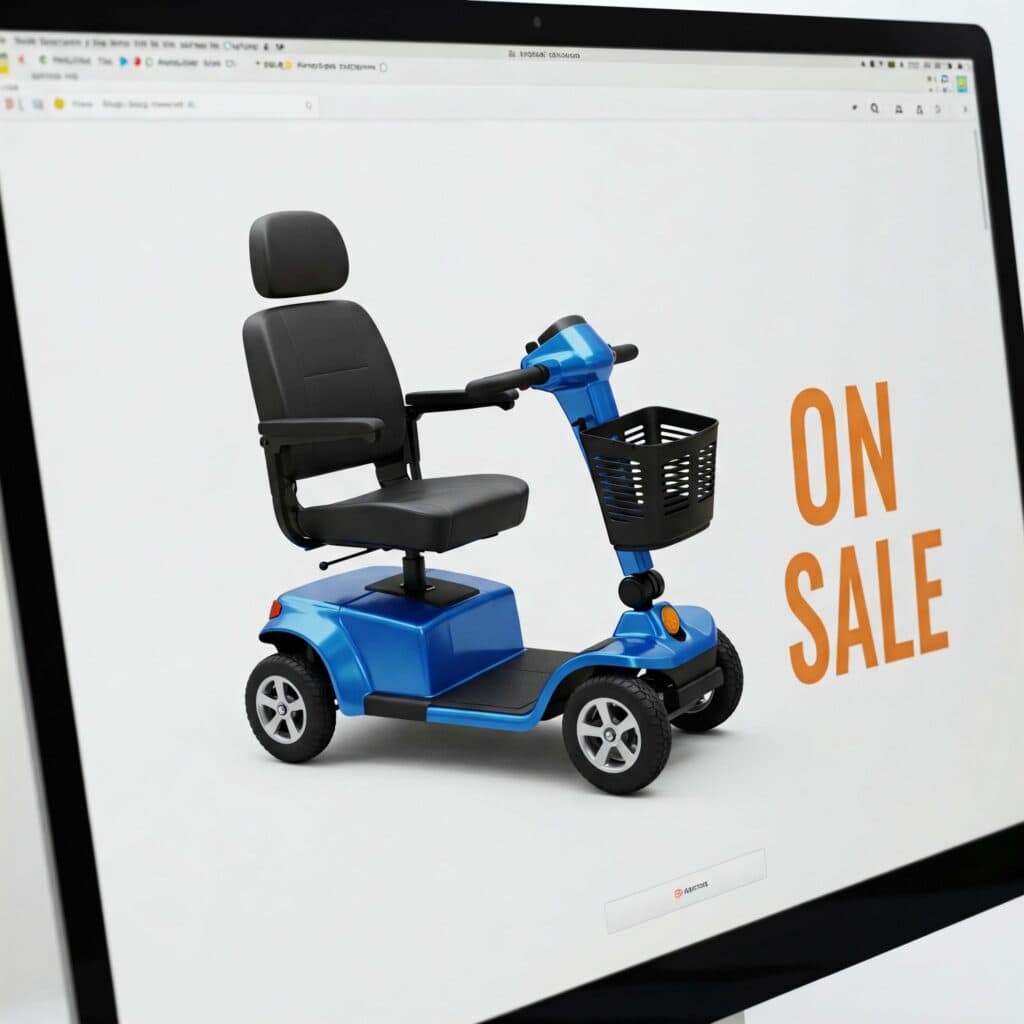Buying a mobility scooter is a big decision, impacting everything from daily errands to social outings. While online shopping offers incredible convenience, purchasing medical equipment like a mobility scooter online comes with its own set of considerations. Buying a mobility scooter online is not as simple as buying a new appliance; it’s about finding the right scooter for your individual needs. This article provides ten essential tips to guide you through a successful online mobility scooter purchase, ensuring you prioritize safety, comfort, and, ultimately, independence.
Tip 1: Prioritize In-Person Evaluation
While online shopping offers convenience, purchasing a mobility scooter is a significant decision that impacts your mobility and independence. Before you click “buy,” prioritizing an in-person evaluation is paramount. This crucial step ensures you select the right scooter for your individual needs and physical capabilities, maximizing safety and comfort.
Importance of a Professional Evaluation: Consulting with a qualified Occupational Therapist (OT) or Physical Therapist (PT) is highly recommended. These professionals can conduct a thorough assessment of your physical abilities, limitations, and specific needs. They’ll evaluate your strength, balance, posture, and range of motion to determine the type of scooter that best suits your physical condition. This personalized evaluation is invaluable in guiding your scooter selection.
Assessment Guides Scooter Selection, Ensures Proper Fit, and Addresses Safety Concerns: The OT or PT’s assessment will help determine the appropriate scooter type (3-wheel, 4-wheel, travel scooter), size, and features. They can advise on seat dimensions, handlebar adjustments, and other ergonomic considerations to ensure a proper fit. A proper fit is crucial for comfort, preventing strain, and maintaining good posture. Furthermore, the evaluation will address safety concerns specific to your needs, such as weight capacity, stability requirements, and any necessary modifications.
Role of Online Research in Preparing for the Evaluation: While a professional evaluation is essential, online research can play a valuable role in preparing for it. Familiarizing yourself with different mobility scooter types, features (like turning radius, ground clearance, and battery life), and available accessories beforehand will allow you to have more informed conversations with the OT or PT. You can explore various models, compare specifications, and identify features that seem important to you. This preparation can help you make the most of your evaluation and ensure that all your questions and concerns are addressed.

Tip 2: Conduct a Thorough Needs Assessment
Before you even start browsing mobility scooters online, it’s essential to understand your specific needs and requirements. A thorough needs assessment will help you narrow down your options and ensure you choose a scooter that fits your lifestyle and enhances your mobility. Consider the following factors to determine the best mobility scooter for you.
Primary Use (Indoor, Outdoor, or Both): Where will you primarily be using your mobility scooter? If it’s mostly for indoor use, such as navigating your home or shopping in stores, a smaller, more maneuverable scooter might be ideal. For outdoor use, consider a scooter with larger wheels, more robust suspension, and a longer battery life. If you need a scooter for both indoor and outdoor use, look for a model that offers a balance of maneuverability and outdoor performance.
Terrain Encountered (Even/Uneven Surfaces, Ramps, Stairs): Think about the types of surfaces you’ll be encountering. Will you be driving on smooth pavements, uneven sidewalks, or grassy areas? If you anticipate navigating rougher terrain, prioritize a scooter with good ground clearance, robust suspension, and pneumatic tires. Consider the inclines and ramps you’ll encounter. Some scooters have limitations on the degree of incline they can handle. Be realistic about your environment and choose a scooter that can handle it safely. Note: mobility scooters are generally not designed for stairs.
Typical Driving Distances: How far do you typically travel on a single outing? This will influence your battery requirements. If you plan on taking longer trips, prioritize a scooter with a longer battery life and consider carrying a spare battery pack. Check the manufacturer’s specifications for the scooter’s range on a single charge and factor in your typical usage patterns.
Weight Capacity and User Weight: Every mobility scooter has a weight capacity limit. It’s crucial to choose a scooter that can comfortably and safely support your weight. Exceeding the weight limit can compromise the scooter’s performance, stability, and safety. Check the manufacturer’s specifications for the weight capacity and ensure it’s sufficient for your needs.
Portability Requirements (Folding, Disassembly, Transportation): How often will you need to transport your mobility scooter? If you plan on taking it in your car frequently, consider a folding scooter or one that can be easily disassembled for transport. Folding scooters are designed for portability and can be easily stored in a car trunk. Disassemble models break down into smaller, manageable pieces, making them easier to lift and transport. Think about the weight and size of the individual components if you choose a disassemblable model.
Tip 3: Measure Carefully
Accurate measurements are absolutely vital when buying a mobility scooter online. Unlike clothing or household items, a mobility scooter needs to fit both your body and your living space. Taking precise measurements ensures comfort, maneuverability, and safety. Rushing this step can lead to a scooter that’s too large to navigate your home or too small to provide adequate support.
Importance of Accurate Body Measurements: Your personal measurements are the foundation for choosing a correctly sized scooter. Pay close attention to seat width, depth, and back height. These measurements determine how comfortably and securely you’ll sit in the scooter. If the seat is too narrow, it can be constricting; too wide, and you might slide around, compromising stability. Accurate measurements also inform the selection of appropriate accessories, like cushions or back supports, further enhancing comfort.
Home Environment Measurements: It’s not enough for the scooter to fit you; it also needs to fit your home. Measure the width of doorways, hallways, and any other narrow passages the scooter will need to navigate. Consider the turning radius of the scooter and ensure there’s enough space to maneuver comfortably in each room. If you have ramps or inclines, measure their slope and width to ensure the scooter can handle them safely. Don’t forget to measure storage spaces too, so you know where the scooter will be kept when not in use.
Basic Checklist of Measurements: To ensure you capture all the necessary measurements, create a checklist. This should include:
- Body Measurements: Seat width, seat depth, back height, leg length (for proper footrest adjustment).
- Home Measurements: Doorway widths, hallway widths, turning space in each room, ramp/incline slope and width, storage space dimensions.
Using Measuring Guides or Templates: Some online retailers or manufacturers may provide measuring guides or templates to assist you. These tools can be particularly helpful for visualizing how a scooter will fit within your home environment. If available, take advantage of these resources to double-check your measurements and ensure a good fit. Remember, accurate measurements are the key to a successful and comfortable mobility scooter purchase.
Tip 4: Research Key Features
Choosing the right mobility scooter involves more than just picking one that looks appealing. Understanding the key features and specifications is crucial for ensuring the scooter meets your individual needs and lifestyle. From turning radius and ground clearance to battery life and climbing ability, each feature plays a role in the scooter’s performance and suitability for your specific circumstances. Thorough research will empower you to make an informed decision and select a mobility scooter that enhances your independence and mobility.
Turning Radius: The turning radius determines how easily you can maneuver the scooter in tight spaces. A smaller turning radius is essential for navigating indoors, around furniture, and in crowded areas. If you anticipate frequent use in confined spaces, prioritize a scooter with a tight turning radius.
Ground Clearance: Ground clearance refers to the distance between the bottom of the scooter and the ground. Higher ground clearance is beneficial for navigating uneven surfaces, such as cracked sidewalks or gravel paths. If you plan to use your scooter outdoors, especially on less-than-perfect terrain, consider a model with ample ground clearance.
Suspension Options: Suspension systems absorb shocks and vibrations, providing a smoother and more comfortable ride. If you have sensitive joints or plan to travel over bumpy surfaces, look for a mobility scooter with good suspension. Different types of suspension systems are available, so research which option best suits your needs.
Seat and Backrest Comfort and Adjustability: Comfort is paramount, especially if you’ll be spending extended periods on your mobility scooter. Consider features like seat width, depth, and height adjustability. A supportive backrest can also make a significant difference in comfort, especially for those with back problems. Look for options that allow you to customize the seating position for optimal comfort and support.
Motor Power and Battery Life: Motor power influences the scooter’s speed and ability to handle inclines. Battery life determines how far you can travel on a single charge. Consider your typical driving distances and the terrain you’ll encounter when evaluating motor power and battery capacity. If you plan to travel long distances or navigate hills, prioritize a scooter with a powerful motor and a long-lasting battery.
Top Speed and Climbing Ability: Top speed is an important consideration, especially if you need to travel quickly. Climbing ability refers to the scooter’s capacity to ascend inclines. Consider the terrain you’ll encounter and choose a scooter with a top speed and climbing ability that meets your needs. Be aware of any local regulations regarding speed limits for mobility scooters.

Tip 5: Read Reviews Critically
User reviews offer invaluable insights into the real-world performance and usability of a mobility scooter. While manufacturer specifications provide a good starting point, it’s the experiences of other scooter users that can truly illuminate the pros and cons of different models. Reading reviews critically can help you make a more informed decision and avoid potential pitfalls when buying a mobility scooter online.
Value of User Reviews: User reviews provide a unique perspective, often highlighting aspects of the scooter that might not be readily apparent from product descriptions or marketing materials. Users share their experiences with day-to-day use, including comfort, ease of operation, durability, and any problems they’ve encountered. This real-world feedback can help you understand how the scooter performs in various conditions and whether it truly meets the needs of scooter users.
Focusing on Key Areas: When reading reviews, focus on those that address key areas relevant to your needs. Look for comments about the scooter’s durability and reliability. Has it held up well over time? Are there any recurring mechanical issues? Pay attention to reviews discussing comfort, especially seat comfort and adjustability. Consider how the scooter handles different terrains and whether the suspension system provides a smooth ride. Safety is paramount, so look for reviews that address stability, braking, and visibility features. Finally, check for comments about ease of use, including how easy it is to assemble, operate, and transport the scooter.
Identifying Reliable and Unbiased Reviews: Not all online reviews are created equal. Some might be biased or even fake. Look for reviews from reputable sources, such as established online retailers or independent consumer review websites. Pay attention to the number of reviews; a larger sample size often provides a more accurate picture. Be wary of reviews that are overly enthusiastic or vague. Look for reviews that provide specific details about the scooter’s performance and the user’s experience. Consider also looking at forums or online communities where mobility scooter users discuss their experiences and share recommendations.
Tip 6: Check Return Policies
Buying a mobility scooter online can feel a bit like a leap of faith. You can’t take it for a test drive in the same way you would in a store. That’s precisely why understanding the retailer’s return policy is absolutely essential. A generous and transparent return policy can provide invaluable peace of mind, especially when dealing with medical equipment where proper fit, functionality, and comfort are paramount. Before you click that “buy” button, thoroughly investigate the return policy to protect yourself from potential issues.
Importance of Generous Return Policies: A strong return policy acts as your safety net. It allows you to return or exchange the mobility scooter if it doesn’t meet your needs or if you encounter unexpected problems. Perhaps the seat isn’t comfortable, the scooter is too large for your home, or it doesn’t handle the terrain you need it for. A good return policy acknowledges these possibilities and provides a clear and fair process for returns or exchanges. It’s not just about getting your money back; it’s about ensuring you end up with a mobility scooter that enhances your independence and quality of life. Don’t underestimate the value of this protection.
Comparing Return Policies Between Retailers: Don’t make the mistake of assuming all online retailers have the same return policies. They can vary significantly, so it’s essential to compare them before making a purchase. Look for specific details: the timeframe allowed for returns, any restocking fees, who is responsible for return shipping costs, and the condition in which the scooter must be returned (e.g., original packaging, no damage).
Some retailers may offer full refunds, while others might only offer store credit or exchanges. Don’t hesitate to contact the retailer’s customer service department to clarify any ambiguities or ask specific questions about the return process. Investing a little time in research upfront can save you from significant frustration and expense later. Remember, it’s your right to be an informed consumer, especially when making a significant purchase like a mobility scooter.

Tip 7: Choose Reputable Sellers
Purchasing a mobility scooter is a significant investment, and choosing the right seller is just as crucial as choosing the right scooter. Reputable sellers not only offer quality products but also provide reliable customer service, transparent policies, and support after the sale. Selecting a trustworthy vendor can make all the difference in ensuring a smooth and satisfactory buying experience when buying a mobility scooter online.
Importance of Buying from Reputable Online Retailers: When buying a mobility scooter online, you’re entrusting your purchase to a vendor you might not meet in person. Reputable online retailers have established a track record of delivering quality products, honoring their warranties, and providing excellent customer service. They are more likely to have secure websites, clear product descriptions, and fair return policies. Buying from a well-known and respected retailer minimizes the risk of encountering scams, receiving faulty products, or experiencing difficulties with returns or warranty claims.
Verifying Seller Credentials, Customer Service, and Return Policies: Before making a purchase, take the time to verify the seller’s credentials. Look for information about their business history, contact details, and customer testimonials. Check online reviews and ratings to gauge their reputation. Pay close attention to their customer service policies. How easy is it to contact them? Do they respond promptly to inquiries? Finally, thoroughly review their return policy, ensuring it’s clear, comprehensive, and addresses potential issues like fit problems or unexpected malfunctions. A reputable seller will be transparent about their policies and readily available to answer your questions.
Tip 8: Inquire About Warranties and Support
When investing in a mobility scooter, especially when buying a mobility scooter online, understanding the warranty and support offered by the seller is paramount. A comprehensive warranty provides peace of mind, protecting you from unexpected repair costs. Equally important is readily available customer support to address any questions or issues that may arise. Don’t hesitate to ask detailed questions about both warranty coverage and support services before making your purchase.
Understanding Warranty Coverage: A warranty is a guarantee from the manufacturer or seller regarding the quality and performance of the mobility scooter. It typically covers defects in materials or workmanship for a specified period. Inquire about the length of the warranty, what specific components are covered (e.g., motor, battery, frame), and what is excluded (e.g., wear and tear, accidental damage). Clarify whether the warranty is transferable if you sell the scooter. Understanding the specifics of the warranty will protect your investment and prevent surprises down the line.
Availability of Repair and Replacement Parts: Even with a warranty, you’ll want to know that repair and replacement parts are readily available. Ask the seller about their process for obtaining parts and how long it typically takes. A quick turnaround time for repairs is crucial for maintaining your mobility and independence. Consider whether the seller has a network of authorized service centers or if you’ll need to handle repairs yourself.
Local Service Centers and Trained Technicians: Having access to local service centers with trained technicians is invaluable. Inquire about the availability of service centers in your area and whether they are authorized to perform warranty repairs. Knowing where to go for maintenance or repairs can save you time and hassle. Confirm that the technicians are experienced in working with your specific scooter model and that they have access to the necessary diagnostic tools and equipment.
Tip 9: Consider Accessibility Features
When choosing a mobility scooter, ease of use and adjustability are paramount for comfort and independence. Think about how you interact with devices and what features would make your experience smoother. Accessibility features encompass everything from the controls to the seating and should be tailored to your individual needs. A well-designed scooter empowers you to navigate your environment with confidence and ease.
Armrests and Footrests (Adjustability, Detachable Options): Adjustable armrests are crucial for finding a comfortable and supportive position. Look for armrests that can be adjusted in height and width to accommodate your body size and shape. Detachable armrests can be helpful for transferring in and out of the scooter or for navigating tight spaces. Similarly, adjustable footrests or platforms allow you to customize the leg and foot positioning, preventing discomfort and promoting proper posture. Consider whether you prefer a solid platform or individual footrests based on your comfort and mobility needs.
Seat Elevation Options: Seat elevation, also known as seat lift, is a valuable feature that allows you to raise the seat height. This can be particularly helpful for transferring to and from the scooter, especially for those with limited mobility or strength. A seat elevator can also make it easier to reach objects or interact with people at different heights. Consider whether seat elevation is a necessary feature for your daily activities and choose a scooter accordingly.
Joystick Placement and Customization: For many mobility scooter users, joystick controls are the primary interface for steering and speed control. The placement and customization of the joystick are critical for comfortable and intuitive operation. Consider whether you prefer a centrally mounted joystick or one that can be positioned on either side of the seat. Some joysticks offer adjustable sensitivity and programming options, allowing you to fine-tune the control to match your abilities and preferences.
If possible, visit a brick and mortar retail location to test different joystick configurations to find the one that feels most natural and comfortable for you. (and don’t feel too guilty about the fact that you actually intend to make your purchase online instead of in-store – heck, you might find such a great deal in-store that you won’t even need to consider buying a mobility scooter online after all!)
Tip 10: Factor in Transportation
When choosing a mobility scooter, it’s essential to consider how you’ll transport it. Whether it’s for a trip to the grocery store, a visit to family, or exploring new places, transportation logistics play a significant role in maximizing the utility of your scooter and maintaining your independence. Thinking about weight, portability, vehicle compatibility, and available transportation options will ensure your scooter seamlessly integrates into your lifestyle.
Scooter Weight and Folding Mechanisms: The weight of your mobility scooter directly impacts how easily it can be lifted and transported. If you anticipate frequently moving the scooter, opt for a lightweight model or one with a convenient folding or disassembly mechanism. Consider who will be lifting the scooter – will it be you, a family member, or a caregiver? Folding mechanisms vary between models, so research how easily and compactly the scooter folds down for storage and transport. Some scooters can be disassembled into smaller, more manageable pieces, which can be helpful for lifting and fitting into car trunks.
Vehicle Compatibility and Accessibility: Before purchasing a mobility scooter, carefully assess your vehicle’s compatibility. Measure the interior dimensions of your car, van, or SUV, paying particular attention to the trunk opening and cargo space. Consider the height and width of the scooter when folded or disassembled to ensure it fits comfortably. If you plan to use a ramp or lift to load the scooter into your vehicle, factor in the weight and dimensions of the ramp or lift itself, as well as your vehicle’s towing capacity if applicable. Ensure your chosen transportation method (personal vehicle, public transport, etc.) is accessible and can accommodate the size and weight of your scooter.
Transportation Options (Personal Vehicle, Public Transport): Think about how you’ll primarily be transporting your mobility scooter. If you’ll be using a personal vehicle, ensure you have the necessary modifications, such as a ramp or lift, and securement devices to safely transport the scooter. If you plan to use public transportation, research the accessibility policies of your local transit authority.
Many buses and trains are equipped with designated spaces for mobility devices, but it’s crucial to confirm the size and weight restrictions and plan your routes accordingly. Also, explore other options like paratransit services or specialized transportation for individuals with disabilities, which may be available in your area. Thinking about these options in advance will help ensure your scooter is a tool for freedom, not a source of transportation challenges.
Some Final Thoughts…
In conclusion, selecting and buying the right mobility scooter online requires careful consideration and a personalized approach. By prioritizing an in-person evaluation (Tip 1), conducting a thorough needs assessment (Tip 2), and taking accurate measurements (Tip 3), you establish a solid foundation for a successful purchase. Researching key features (Tip 4), reading reviews critically (Tip 5), and understanding return policies (Tip 6) empower you to make informed decisions. Choosing reputable sellers (Tip 7), inquiring about warranties and support (Tip 8), and considering accessibility features (Tip 9) ensure long-term satisfaction and peace of mind. Finally, factoring in transportation (Tip 10) allows your mobility scooter to seamlessly integrate into your life, expanding your horizons.
Remember, the ultimate goal is to enhance your independence, comfort, and safety. Don’t rush the process. Take your time, do your research, and consult with healthcare professionals. Your ideal mobility scooter is out there, ready to empower you. One final piece of advice: before you click “buy,” double-check everything. Review the order details, confirm the return policy, and ensure all your questions are answered. A little extra diligence can prevent future frustrations and ensure a smooth and successful purchase when buying a mobility scooter online.
Some Other Questions That People Also Ask:
- How much does a mobility scooter cost? The price of a mobility scooter can vary significantly based on factors like type (3-wheel, 4-wheel, travel), features, brand, and retailer. Basic models might start around a few hundred dollars, while more advanced, feature-rich scooters can cost several thousand. Consider your budget and explore potential funding options like insurance coverage or financial assistance programs.
- What are the different types of mobility scooters? Mobility scooters are broadly categorized into 3-wheel, 4-wheel, and travel scooters. 3-wheel scooters offer greater maneuverability, particularly indoors, while 4-wheel scooters provide more stability, especially on uneven terrain. Travel scooters are designed for portability, often folding or disassembling easily for transport.
- Can I get a mobility scooter covered by insurance? Depending on your insurance provider and the medical necessity of the scooter, some coverage may be available. Medicare and private health insurance may cover a portion or all of the cost if a physician prescribes the scooter and it meets specific medical criteria. Contact your insurance provider to understand your coverage options and any pre-authorization requirements.
- How do I choose the right battery for my mobility scooter? Battery selection depends on factors like the scooter’s motor, your typical usage (distance and frequency), and charging habits. Battery capacity is measured in amp-hours (Ah), with higher Ah ratings generally translating to longer driving ranges. Consult with the scooter retailer or a healthcare professional to determine the appropriate battery type and capacity for your needs.
- What are the benefits of a three-wheel mobility scooter? Three-wheel mobility scooters offer several advantages, primarily their enhanced maneuverability. Their tighter turning radius makes them ideal for navigating crowded spaces, narrow hallways, and indoor environments. They often have a smaller footprint than four-wheel scooters, making them easier to store and transport. However, they may be less stable on uneven terrain compared to four-wheel models.

